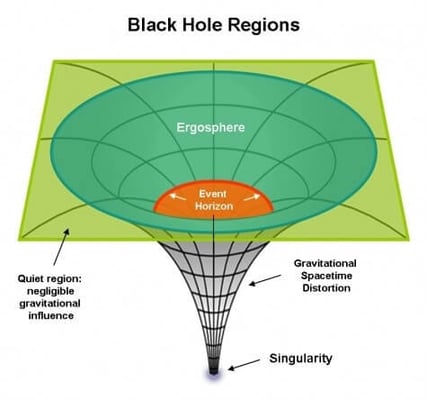Black Hole; A Mysterious Region in Space

Regions of Black Hole. Image © Ask The Van / UIUC Physics Department.
A black hole is a region in a space where the gravitational pull is so strong that no object, even electromagnetic radiation like light can not escape from the region. The boundary of the region from where nothing can escape is called an event horizon. The idea of such a massive object that even electromagnetic radiation can not escape was proposed by John Michell in November 1782. Michell also noted that such a supermassive, non-radiating body might be detectable by their gravitational effects on the visible nearby objects.
Related: Black Holes: How they work?
Adding more about black holes, mathematicians and physicists like Karl Schwarzschild, Albert Einstein, Subrahmanyan Chandrasekhar, and others, theoretically figured out the properties that a black hole bears like radius, mass, and the event horizon. To add more, Karl Schwarzschild in 1916 solved and obtained the exact solution to Einstein’s field equation for a gravitational field outside a non-rotating symmetric body. Through that formulation, Schwarzschild claimed that any object with a physical radius smaller than its Schwarzschild radius will be a black hole. The mathematical form of the Schwarzschild radius is:
![]()
Where G is the gravitational constant, M is the mass of the object, and c is a universal constant called the speed of light.
Physically, this signifies that the Schwarzschild radius determines if the objects like stars will become a black hole or not, and also this radius defines the region of the event horizon.
Using this concept of Schwarzschild radius, the Sun has a Schwarzschild radius of approximately 3 km and it has been predicted that our star- Sun- can not be a black hole.
The distance from the centre of the black hole to the region of the event horizon is the Schwarzschild radius.
Astronomers have identified mainly three types of black holes:
1) Stellar black holes
3) Supermassive black holes
These classifications are mainly based on the mass of the black holes.
What do black holes look like?

On April 10, 2019, a research team at Event Horizon Telescope involving international collaboration team announced, by series of six papers published in a special issue of The Astrophysical Journal Letters, that they have succeeded on unveiling the first direct visual evidence of a supermassive black hole and its shadow. The image revealed by the team was of a black hole at the centre of Messier 87 and lies at 55 million light-years from Earth and has a mass 6.5 billion times that of the Sun.
